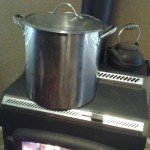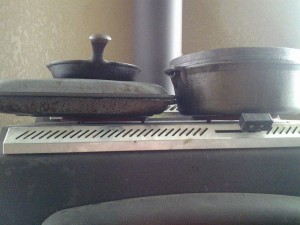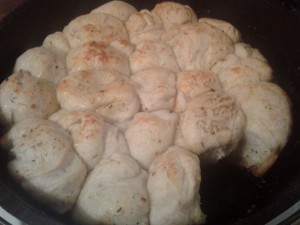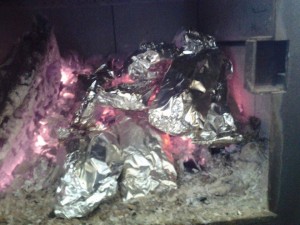I just completed a week of cooking every meal on our wood stove. I intend to go a whole month like this because I am very curious to see how much money this is saving on our electric bill. I am brand new at this, but I wanted to capture my recent experiences and share with you the things I found to be extremely helpful while it’s still in my mind. I gladly welcome any feedback, tips or advice!
First of all, I started off with typical ‘campfire’ recipes. I thought that would be best considering I was going a lot of cooking over open flame (one of my wood stoves has a cook top where the cooking spots can lift out so you can set a skillet directly over the flame). I quickly learned that ANY recipe (as far as I know!) cooked on the stovetop and be used on the wood stove. Cook like you normally do and continue to enjoy your favorite meals.
Cooking over wood heat can take longer if you don’t have a rockin’ fire going. A rockin’ fire will use a little more wood, but in the whole scheme of things you are talking a few extra pieces on top of your normal fire for the day. I don’t yet have a cradle for my wood (inside the stove), and I am wondering if that would be helpful to bring the flame a little closer to the top of the stove with the help of a cradle/grate instead of having to build up a high fire from wood. Not everything needs a rockin’ fire either. Simmering soups, sauces, and slow cooked meals (think crock pot) can all probably be cooked on your stove top with a normal fire. I normally wake an hour or two before my family, so I have been throwing oatmeal on the stove top each morning to slowly heat and cook until my kids rise.
Wood heat is not exact. You will need to eyeball your food here and there, adjust your fire by adding a log, or lowering the flame by moving logs side by side, or adjusting your damper. Certain wood burns quicker and hotter than others, so you will get to know what kind of wood to put in your stove to get a good cooking fire going. You can get a thermometer to help determine the temperature of your stovetop. You will get to know the temperament of fire quite well by cooking with it and once you get the hang of it, building your fire and tending to it while you tend your food becomes second nature. If you are just starting your fire instead of cooking over an already established one, you will need to let your stove heat up a bit before you try cooking over it. Likewise, heat your cookware on the stove before beginning to cook on it, too.
In the past week I have cooked oatmeal, browned beef, thawed meats, rose bread, baked yeast rolls, baked (and burnt) cornbread (but I kind of forgot about it while putting my son down for a nap… user error. After peeling off the burn, I got 8 thumbs up, including my own for good taste), chili, beef tips and gravy, stir-fried, sauteed, pan seared, boiled water for pasta, cooked beef and barley soup, reheated food, melted butter, baked biscuits, cooked eggs,simmered sauce, and cooked sausage patties. I think that sums up my past week. I have wanted to try all aspects of our normal cooking, and was well pleased. A few weeks ago I simmered rabbit stock all day in a huge stock pot, too.
You will find that your stove has hot spots and milder spots. Of course, the spot right on top of your fire is going to be hot. Our main wood stove that heats our home has a step down top, meaning one level is higher than the other (as pictured above). The higher end is great for simmering. I put a cast iron tea kettle there to add some humidity to the air, simmer spaghetti sauce, all of my lower-heat applications work great there. I can get smaller quantities of liquid to boil if needed, too. My other wood stove is long and narrow. I burn a fire in the front of that stove to sufficiently heat the whole unit. Where you place your fire is important. Too far back, and it doesn’t do you much good for cooking because the fire will be under the stove pipe.
Trivets will be your friend. If your stove is too hot for what you’re cooking or it’s cooking too quickly, you can add a trivet to get it directly off the cook top. I have metal trivets that work great, but anything that won’t melt or catch fire will work for this purpose – even canning rings. If your wood stove has a dedicated cook top where circles can be removed for your skillets to sit in and cook directly over open flame, you can put the circles back in if things are cooking too fast/are too hot, and also add a trivet if need be. For baking, trivets are essential to prevent over-cooking the bottom of whatever you are baking. Dutch ovens are also essential to great baking on your stove, they seem to mimic the oven the best.
Speaking of baking, I experimented with baking traditional biscuits and yeast rolls along with cornbread this week. I looked all over the internet to gather all the tips I could to be successful. Many people said baking traditional biscuits wasn’t possible. I’m here to say: yes they are! I made my biscuit dough as usual and tried to bake them two ways – on a broiler tray, the bottom greased with nonstick spray with another tray over the top weighed down with a small skillet, and in a dutch oven lined with parchment paper. Both ways were on a trivet to help keep the bulk of the heat off the bottom of the biscuits. Baking them in between the trays was most successful. I flipped them about halfway through.
I also baked yeast rolls in the dutch oven with great success. They were nicely browned on the bottom, cooked all the way through, and started to brown a bit on the top. I was worried the bottom would burn so I didnt want to cook them much longer than I already had – we added hot coals on top of the lid of the dutch oven to cook the tops of the rolls which were still undercooked near the end. Next time I will add hot coals sooner. I used a trivet, and figure I will use a trivet for all ‘baking’ applications.
Another method of cooking I found fun was cooking in tin foil. I would make individual meals in packets of foil and throw them right on the coals in the firebox. They cooked great – were very moist – but my only issue was the amount of foil it took for my family size. I am assured that I can still cook the types of recipes you would cook in tin foil, in a dutch oven, with great results.
I have had a blast cooking over my wood stoves for the past week and am excited to see what new things I can learn in the coming week. Do you have any tips to share?




What’s up everyone, it’s my first visit at this
web page, and paragraph is really fruitful in favor of me, keep up posting these types of articles.
I’m truly enjoying the design and layout of your blog. It’s a very easy on the eyes which makes
it much more enjoyable for me to come here and visit more often. Did you hire out a developer to create your theme?
Great work!
Informative article, exactly what I was looking for.
Hello I am so delighted I found your web site, I really
found you by mistake, while I was searching on Askjeeve for something else, Anyways I am
here now and would just like to say many thanks for a remarkable post and a all round entertaining blog (I also love
the theme/design), I don’t have time to look over it all at the moment but I have bookmarked it and also added in your RSS feeds, so when I have time I will be
back to read much more, Please do keep up the superb b.
Howdy would you mind letting me know which webhost you’re using?
I’ve loaded your blog in 3 different browsers and I must say
this blog loads a lot faster then most. Can you suggest a good internet hosting provider at a honest price?
Many thanks, I appreciate it!
obviously like your web-site but you need to check the spelling on quite a few of
your posts. A number of them are rife with spelling problems and I find it very bothersome to inform
the truth however I will surely come again again.
Do you mind if I quote a few of your posts as long as I provide credit and
sources back to your website? My website is in the exact same area of interest
as yours and my visitors would certainly benefit from a lot of the information you
provide here. Please let me know if this alright with you.
Thank you!
After exploring a number of the blog articles on your
web page, I truly appreciate your way of blogging.
I bookmarked it to my bookmark webpage list and will be checking back soon. Please check out my website as
well and tell me your opinion.
I’m not that much of a internet reader to be honest but your sites
really nice, keep it up! I’ll go ahead and bookmark your site to come back in the future.
Cheers
Very good info. Lucky me I discovered your site by accident (stumbleupon).
I have book-marked it for later!
Great post. I was checking continuously this blog and I’m impressed!
Very useful info particularly the last part :
) I care for such information a lot. I was looking for this certain information for
a long time. Thank you and best of luck.
Hi there! This blog post couldn’t be written any better!
Looking through this article reminds me of my previous roommate!
He continually kept talking about this. I will forward this
article to him. Pretty sure he’s going to have a very good read.
Many thanks for sharing!
What’s up to every one, the contents present at this web page are
genuinely awesome for people experience, well, keep up
the good work fellows.